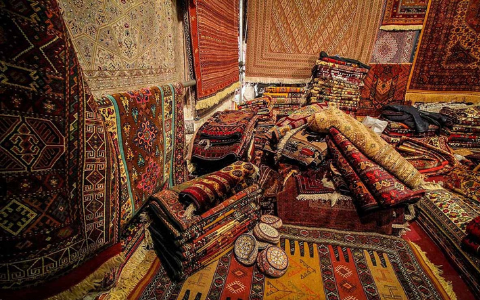Unless we shop for knock-offs or mass-produced items, we all know how expensive rugs can be. At the very least, a typical low-end Persian or Turkish rug can cost a few hundred dollars. And if we were to buy an authentic, vintage masterpiece, the price will go into tens of thousands, or even hundreds of thousands. Yet, amazingly, some rugs managed to go for a few million!
So, what is it that makes a rug so expensive? Does an authentic rug even need to cost as much as a luxury car or a speedboat? What are the factors that decide the price of a carpet? This article will try to answer all of that and more. We will provide everything our readers need to know regarding the value of rugs and why their price tag is as hefty as it is.
Determining the Price of a Rug

Several key factors go into estimating the value of each rug. It’s not exactly rocket science, and nearly all of the factors we’re about to list will make a lot of sense to the uninitiated. After all, most people who are not into rugs don’t consider the time and effort to create them. And to be fair, most people also tend to think in terms of practicality and frugality, which is perfectly fine. Our fellow future rug owners, on the other hand, should start taking notes. Here are the factors that determine how much a rug will cost.
Handmade Rugs vs. Machine-made Rugs

A piece of art made by human hand will cost more than anything mass-produced. Nowadays, power looms can create hundreds of cheap, low-quality rugs for anyone to use. These rugs are okay if we’re looking to save money, but they have zero artistic value and no soul.
A handmade rug is another story altogether. The most high-valued rugs, such as Turkish rugs, come from countries and regions where weaving is part of a long-standing tradition, sometimes spanning a few millennia. A master weaver doesn’t just create a carpet for everyday use (though granted, they still do in many Middle-eastern and North African countries). They are weaving a bit of their personality and artistic outlook on life into the rug. Each and every knot is made by hand, with great care and skill. That alone makes the rug an incredibly worthwhile investment.
Knot Count and Knot Density of a Rug

Both of these factors are intertwined (some pun intended), hence why we’ve decided to list them together. Each rug with a high knot count will have a high price tag since these types of rugs are challenging to make. In addition, the more dense the knots are, the higher the quality of the piece. When the artist has many knots to work with, they can create some spectacular imagery with vivid, breathtaking detail. It’s a little like comparing the pixel count of a 1920 x 1080 image (modern high-definition TV sets) and a 720 x 576 image (standard definition TV sets with a 4:3 aspect ratio).
Rug Patterns, Colors, and Other Details

Sometimes, just looking at the rug will let us know how valuable it is. “There are some patterned rugs, for example, which are pretty rare and difficult to find. In addition, the quality of color can factor in the price (ex. is it faded or vivid, what types of pigments were used, etc.). Even the name of the weaver can hike the price up. If it’s a well-known name, we will have to pay a little extra, with that ‘little’ amount going up several thousands of dollars.
Age of a Rug

Generally, but not always, rugs cost more the older they are. For instance, a rug that’s a few centuries old from a culture or a civilization that no longer exists can make you a millionaire overnight. But, of course, it has to be in decent condition, and experts have to verify its age. Such rugs are genuine historical artifacts that have a lot more to them than mere artistic value. They are objects that historians study and reveal a lot about the culture that produced them.
How Are Expensive Rugs Made?
The process of making a single, average rug is incredibly difficult, tedious, and even back-breaking. More often than not, it will require several people working on a single standard-sized rug for 14 months, at the very least.

Let’s cover everything that goes into creating a single rug. First and foremost, we need material. That means herding sheep for high-quality wool, taking care of a cotton field, or maintaining hundreds of silk bugs in one spot. Getting wool, cotton, and silk will take a lot of time and effort, and we haven’t even started weaving yet.
Next, there’s the process itself. We would need to spin the material and dye it using only the hand spindle. Once we’ve done about 7-8 hours of spinning, we have enough material for an hour of knotting. That’s an insane amount of working hours for such a measly result!

Naturally, we would divide the labor, i.e., some people would farm for materials, others would spin, and others would weave. On average, a typical 9’ x 12’ rug with 500 knots per square inch will take six weavers about six hours a day, six days a week to complete, and even then, it would take over a year. Keep in mind; we’re talking about an average rug here; most high-quality rugs have well over 1000 knots per square inch.

Calculating the price of labor alone, the weavers alone would have to be paid over $10.000 per rug. Factor in all other workers and all of the materials you need to use, and that price tag is already reaching close to a million.
Handmade Rugs Are a Piece of Fine Art

To the uninitiated, these price tags for handmade rugs seem outrageous. However, keep in mind that many modern art pieces tend to sell for at least three times more than an average antique rug. And more often than not, these fine art pieces are anything but fine. Aesthetically they might be some of the ugliest, most unappealing objects you will ever see. For example, a Cy Twombly piece once sold for well over $70 million. Said piece looked like someone grabbing a brush and scribbling all over the canvas. In comparison, an antique 17-century Persian rug was sold at a Sotheby’s auction in 2013 for around $33.7 million. That’s an incredible difference, especially when we consider just how old and intricate the rug is compared to Twombly’s ‘art piece’.
So Why Are Handmade Rugs Expensive?

The effort, time, and hard work that goes into each and every vintage rug should more than explain why they are so valuable. But it goes beyond that. Unlike many modern rugs, these masterpieces are a direct expression of their author, and as such, they ought to be treasured. So, the next time you spend tens of thousands of dollars on a rug, take heart. You are investing in a piece of art with decades, if not centuries, of history, compassion, and soul.

